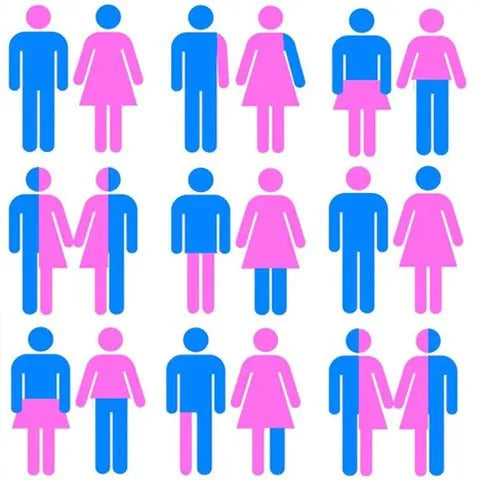
What Does It Mean to Be All-Gender?
"All-gender" or “gender nonconforming” is a term given to people who don’t conform with the gender norms that are expected of them.
The term usually refers to gender expression or presentation (that is, how someone looks and dresses). It can also refer to behavior, preferences, and roles that don’t conform to gender norms.
In other words, gender nonconforming can be used to describe people as well as actions, dress, and ideas.
Being all-gender doesn’t necessarily mean you’re transgender or nonbinary, although you could be both.
So, what’re the basics?
We can define gender expectations as the roles, dress, behavior, and appearance society expects people of certain genders to have.
For example, in one specific society, women might be expected to shave their legs and men might be expected to not show vulnerability.
Most of us don’t fully conform to those gender expectations all of the time.
For example, many women choose not to shave their legs, and many pursue careers over marriage and children. Many men show vulnerability and wear nail polish.
"Of course, because gender expectations differ from one society and culture to the next, what’s considered gender nonconforming in one culture might not be in another"
In many American cultures, these would be considered examples of gender nonconformity:
- A man might show emotion and tenderness.
- A woman might wear a suit on her wedding day instead of a dress.
- A man might wear eyeliner.
- A woman might pursue a career instead of marriage or motherhood.
- A man might shave under his armpits.
- A woman might be assertive.
- A man might be a stay-at-home dad.
By the above standards, most folks are gender nonconforming — very few people conform fully to gender expectations. So, is everyone all-gender? Does that label apply to everyone?
Not necessarily. The term “all-gender” is typically used to describe someone who intentionally subverts these gender norms.
A part of their gender expression may be to dress, behave, or present themselves in a gender-nonconforming way.
"While some people feel that all-gender is a part of their identity, for others, it’s more of a decision and an action than an identity"
So, if you want to identify with gender nonconformity, or if you want to use the term to describe yourself, your gender expression, or your social expression, you can do so. It’s a matter of your own preference.
Where did the term originate?
According to Merriam-Webster, the first recorded use of the term was in 1991, when Lisa M. Diamond, Susan B. Bonner, and Janna Dickenson wrote:
“Gender identity refers to an individual’s internalized psychological experience of being male or female, whereas gender nonconformity refers to the degree to which an individual’s appearance, behavior, interests, and subjective self-concept deviate from conventional norms for masculinity/femininity.”
Where do gender roles come in?
Gender roles include the behaviors, attitudes, and values that you’re expected to have based on your gender. Gender roles vary among cultures.
In many American cultures, for example, gender roles determine:
- which gender is expected to pursue another romantically
- which gender is expected to be the breadwinner or sole provider of a household
- which gender is expected to take care of domestic duties
Many people don’t conform to these gender roles. This could be an example of gender nonconformity.
Is your only other option to be gender conforming?
By definition, being gender nonconforming means you don’t conform to gender expectations. The term “gender conforming,” on the other hand, is seldom used.
As mentioned, most people don’t fully conform to gender expectations — the majority of us conform in some ways and subvert it in other ways.
Try not to think about it as choosing between gender conformity and gender nonconformity. Think of it as living your life authentically, no matter whether it “matches” the expectations placed on your gender.
Can anyone be gender nonconforming?
Yes, anyone of any gender can be gender nonconforming.
Being gender nonconforming isn’t the same as being nonbinary, although some people identify with both terms.
"You don’t have to be nonbinary or transgender in order to be gender nonconforming"
For example, a cisgender man might wear nail polish as an expression of his gender. This doesn’t necessarily mean that he’s nonbinary, but it can be a way for him to stop conforming to gender norms.
Many people argue that nonbinary people are, by definition, gender nonconforming because they don’t conform to the gender binary or the gender expectations placed on them by society.
But it all comes down to the individual’s personal preference. You’re the only one who gets to decide what applies to you or how you want to be described.
What might this look like in practice?
Gender nonconforming actions can be big or small. Again, it’s important to remember that gender nonconformity depends on the cultural context.
If, in your culture, women are expected to grow their leg hair instead of shave it, fitting into this norm wouldn’t be considered gender nonconforming.
Gender nonconformity can look like wearing “men’s” instead of “women’s” clothing for some, but not for everyone. It could also look like wearing androgynous clothing.
Gender nonconformity can extend to:
- hairstyles (a man having long hair or a woman shaving hers off, for example)
- makeup or a lack thereof
- grooming practices
While the term usually applies to gender expression, it can also include attitudes, gestures, gender roles, and more.
What makes this different from being genderqueer or gender-fluid?
Being gender nonconforming is often more about gender expression, while being genderqueer or gender-fluid is more about gender identity.
Being genderqueer is having a gender identity that falls outside of heterosexual, cisgender norms. Being gender-fluid is having a gender identity that changes and shifts over time.
That said, some do use the term “gender nonconforming” to describe their gender identity — it really varies from person to person.
Gender nonconforming people might be genderqueer or genderfluid, but this isn’t always the case. A gender nonconforming person might identify fully as a man or woman.
Why might someone opt to use this term over others?
Gender nonconforming is a useful word to describe gender expression that falls outside of gender norms.
It’s also a broad term: Gender nonconforming could include feminine, masculine, or androgynous traits, or a mixture of the three.
This term can be ideal for people who enjoy playing around with gender expression or dressing in certain ways but who don’t want to use a specific word to cover their gender identity.
How do you know if it’s the term for you?
The label you choose to use is entirely your choice. However, it isn’t always easy to know which label to choose.
There’s no “test” to figure out whether you should describe yourself as gender nonconforming or not.
To figure it out, you can try the following:
- Talk to gender nonconforming people on forums or online groups, or in real life, to hear what being gender nonconforming means to them.
- Read about the experiences of gender nonconforming people, and ask yourself whether you relate. Bear in mind that everyone’s experience is different.
- Consider which aspects of your gender expression you consider to be gender nonconforming. How do they not conform? Is this subversion important to you?
- Try the term out by referring to yourself as gender nonconforming, either out loud or in written words. You don’t need to share this with anyone if you don’t want to. Just try it and see how it feels.
Remember that there’s no right or wrong answer. You’re allowed to describe your gender however you see fit.
What happens if you no longer feel like this term fits?
Many people find that their gender identity and expression changes over time. This is quite common. If this is your experience, that’s OK! It doesn’t make your experience any less valid.
How can you support the all-gender or gender nonconforming people in your life?
Being gender nonconforming can be difficult for many people because of the stigma associated with breaking away from gender expectations.
Supporting the gender nonconforming people in your life can include educating people about gender nonconformity.
It can be as simple as teaching your kids about gender identity and gender expression. It could also include challenging people who look down on gender nonconforming people.
If you have a gender nonconforming loved one, give them space to talk about being gender nonconforming without expecting them to talk about it (as they might not want to).
Accept it and celebrate it as a part of them. Ask if there are any specific ways you can support them.
Where can you learn more?
If you want to learn more about gender, there are many online resources out there. For example:- Nonbinary Wiki is a wiki-type site that includes a lot of information relating to gender identities.
- Genderqueer.me has a thorough list of resources on gender identity and related topics.
- Book Riot has a list of books about gender identity, including both fiction and nonfiction books.
You can also check out our list of 64 different terms to describe gender identity and expression.
Sian Ferguson is a freelance writer and editor based in Grahamstown, South Africa. Her writing covers issues relating to social justice, cannabis, and health. You can reach out to her on Twitter.
| This article is sourced from: https://www.healthline.com/health/gender-nonconforming#learn-more. This transformative remix work constitutes a fair-use of any copyrighted material as provided for in section 107 of the US copyright law. “What Does It Mean to Be Gender Nonconforming?” by Sian Ferguson is licensed under a Creative Commons BY-NC-SA 3.0 License – permitting non-commercial sharing with attribution. |













